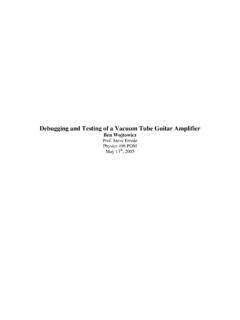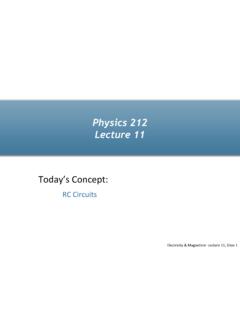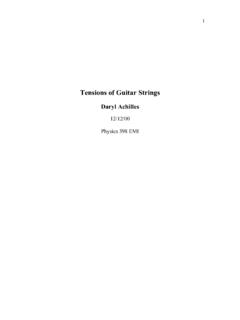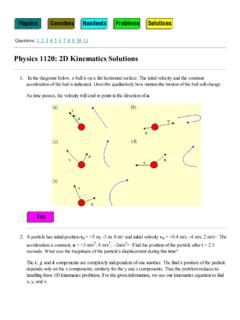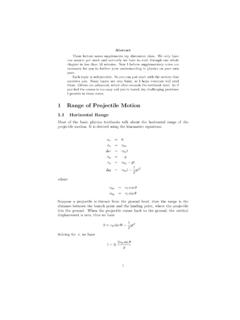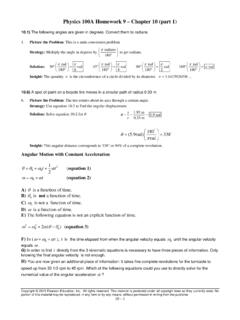Transcription of Work and Kinetic Energy: Block on Ramp - University of …
1 Physics 211 Week 5 work and Kinetic energy : Block on ramp A Block starts with a speed of 15 m/s at the bottom of a ramp that is inclined at an angle of 30o with the horizontal. The coefficient of Kinetic friction between the Block and the plane is = The Block goes up the ramp , momentarily comes to rest, and then slides back down the ramp . What is the speed of the Block when it reaches the bottom of the ramp ? This problem can be solved using the work - Kinetic energy theorem. You can begin by finding the distance that the Block will travel up the ramp . The Block starts with Kinetic energy at the bottom of the ramp and has gravitational potential energy when it momentarily comes to rest at the top; however, it loses some energy to the work done by friction.
2 A free body diagram can help you determine the force of friction on the Block by using Newton s second law. The work done by friction is equal to the force of friction times the distance the Block travels up the ramp . The change in gravitational potential energy will also depend on the distance traveled up the ramp . Now you can create a work - energy equation relating the initial Kinetic energy , work done by friction, and change in gravitational potential energy . After you have rearranged the equation to obtain an expression for the distance the Block travels up the ramp , you can next look at the Block sliding back down the ramp . On the way down, the gravitational potential energy is changed to Kinetic energy and work done by friction.
3 The work done by friction while sliding down the ramp will be the same expression you used to determine the work done moving up the ramp since the force of friction and distance over which it acts are the same in both directions of travel. Create another work - energy equation for the gravitational potential energy , Kinetic energy , and work done by friction for the way down the ramp . The expression for the Kinetic energy at the bottom of the ramp contains the final speed of the Block . You should find the speed at the bottom of the ramp to be m/s. Physics 211 Week 5 energy Conservation: Roller Coaster (solutions) A roller coaster car has a mass of 840 kg.
4 It is launched horizontally from a giant spring, with spring constant 31 kN/m into a frictionless vertical loop-the-loop track of radius What is the minimum amount that the spring must be compressed if the car is to stay on the track? energy is conserved during travel of the coaster. The spring potential energy stored in the compressed spring becomes gravitational potential energy and Kinetic energy when the coaster is at the top of the loop. The height to use in determining the gravitational potential energy is simply the diameter of the loop. To find the speed of the coaster at the top of the loop, identify the forces that contribute to the centripetal acceleration.
5 Drawing a free body diagram of the coaster at the top of the loop shows that both gravity and the normal force are center pointing. To satisfy the condition that the car stays on the track, we can assume that the minimum amount of compression would cause the car to just barely make it. This means that the normal force will be zero at the top. Therefore, the centripetal acceleration is just g. Using the centripetal acceleration to derive an expression for the velocity, you can then obtain the Kinetic energy at the top of the loop. With both the Kinetic energy and gravitational potential energy , you can find the spring potential energy and then the spring compression.
6 You should obtain a compression of m. r Physics 211 Week 5 Momentum: Romeo and Juliet (Solutions) Romeo, who is sitting in the rear of their boat in still water, entertains Juliet by playing his guitar. After the serenade, Juliet, who was sitting in the front of the boat, carefully moves to the rear to plant a kiss on Romeo's cheek. The 80-kg boat is facing shore and the 55-kg Juliet moves m towards the 77-kg Romeo. How far does the boat move? Does it move toward or away from the shore? Conceptual Analysis: - There are no outside forces so the center of mass does not move during Juliet s motion . - If Juliet is moving away from the shore and the CM does not change, then the boat must move under Juliet towards the shore to compensate for her change in position.
7 - The center of mass of the boat is located in the middle of its length. - After Juliet moves, she and Romeo are located in the same position. Strategic Analysis: - Set up a convenient coordinate system. - Find an expression for the CM before Juliet moves. - Find an expression for the CM in terms of the shift of the boat, x, after Juliet has moved. - Equate the CM expressions to find the shift of the boat. Quantitative Analysis: - Begin by labeling the given quantities: J mass of Juliet R mass of Romeo B mass of the boat L length of the boat We are solving for x how far the boat moves - Create a convenient coordinate system.
8 One option is to make the end of the boat where Juliet is originally sitting position zero. J R L B Shore 0 - Next you can set up an expression for the center of mass before Juliet moves: xCM = (mi*xi) / (mi), that is, the position of the center of mass is equal to the sum of the products of the mass components and their positions divided by the sum of the mass components. Isolating the position-mass products, the expression then becomes: J(0) + R(L) + B(L/2) = xCM * (J+R+B) - Then an expression for after she moves using the shift, x (x is positive when the boat moves toward the shore): (J + R)(L - x) + B(L/2 - x) = xCM * (J+R+B) - You can then equate the two expressions to solve for the shift: J(0) + R(L) + B(L/2) = (J + R)(L - x) + B(L/2 - x) Expand: J(0) + R(L) + B(L/2) = J(L) + R(L) - J(x) - R(x) + B(L/2) - B(x) Simplify: 0 = J(L) - J(x) - R(x) - B(x) Solve for x: x = J(L) / (J + R + B) Insert values.
9 X = (55 kg * m) / [55 kg + 77 kg + 80 kg] = m The boat will move towards the shore. Physics 211 Newton's Laws: Determine Friction by Angle A Block of mass M rests on an incline of length L which makes an angle with the horizontal. The angle is slowly increased until the Block starts to move. Let the angle at which the Block starts to move be s. Show how the coefficient of static friction can be determined from the measurement of s. There are three forces acting on the Block : gravity, normal force from the surface, and the frictional force.
10 The moment before the static frictional force is overcome, there is no motion ; therefore, all of the forces must sum to zero. You can create a free body diagram to evaluate the forces. Perpendicular to the plane, there is a component of the gravitational force and the normal force. Since they must sum to zero and they are in opposite directions, their magnitude must be the same. You can break the gravity into components to determine the value of the perpendicular component. Parallel to the plane you will find the other component of gravity as well as the force of friction. The force of friction is just the coefficient of friction times the normal force, which you found a value for while evaluating the perpendicular force components.



